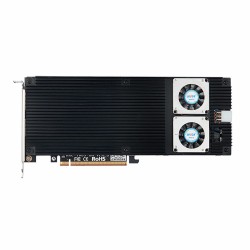- favorite 0 likes
- comment 0 comments

The development of artificial intelligence and modern computing methods increasingly depends on efficient hardware infrastructure. In addition to processors and graphics cards, which play a key role in training and running models, the importance of fast storage media is growing. In this context, M.2 NVMe drives occupy a special place, as they prove to be an indispensable component of modern high-performance computing systems in many applications.
The most important advantage of NVMe storage is its enormous bandwidth and low latency. While traditional hard drives can read data at speeds of tens or hundreds of megabytes per second, and standard SATA SSDs reach about half a gigabyte per second, modern NVMe drives can exceed even 10 GB/s in the case of M.2 SSD NVMe models based on the PCIe 5.0 bus. This difference becomes crucial in situations where the system has to work with huge data sets, which is commonplace when working with artificial intelligence.
High input/output operations per second (IOPS) and minimal latency make M.2 SSD NVMe drives great at handling random access data. This is especially important for databases used in AI, such as vector search systems, which need to instantly find similarities between millions of records. Thanks to NVMe technology, this process runs smoothly and without bottlenecks, significantly speeding up the entire system.
Another aspect that is gaining importance is the ability to communicate directly with processors and graphics cards. Modern solutions, such as DirectStorage and GPUDirect Storage, enable data transfer from the disk directly to the graphics card's VRAM, bypassing the RAM and CPU. This means reduced system overhead and faster loading of training data, which in practice shortens the time needed to run and train artificial intelligence models.
The applications of NVMe memory in computing are very broad. In AI model training, they allow for fast loading of huge sets of images, texts, or sound signals, which directly translates into the efficiency of the entire process. In the inference phase, NVMe speeds up model loading and query processing, which is of great importance, for example, in chatbots, recommendation systems, and real-time solutions. In big data and scientific analysis, where petabytes of data are processed, fast drives become an invaluable tool for exploring and filtering information.
Importantly, M.2 NVMe storage is used not only in large data centers, but also in edge devices. Thanks to their compact form and high performance, they are ideal for robotics, autonomous vehicles, and IoT systems, where it is often necessary to train and run artificial intelligence models locally without access to the cloud.
PCIe 5.0 Hardware RAID cards – an additional level of performance and reliability
Although single M.2 NVMe drives offer impressive performance, professional and scientific applications often require further increases in bandwidth, reliability, and capacity. This is where next-generation hardware RAID controllers, such as the Areca ARC-1689-8N offered by our company, Abart Pro, come in handy.
This controller, operating in the PCIe 5.0 standard, allows up to eight NVMe drives to be supported in a hardware RAID configuration. This means that they can be combined into a hardware array that provides both tremendous performance and high fault tolerance. In practice, the user gains:
Bandwidth scaling – combining several NVMe drives in RAID 0 or RAID 10 results in transfer rates exceeding the performance of a single drive, which is important, for example, when training very large AI models.
Reliability and data security – RAID 1, 5, or 6 configurations protect against the effects of disk failure, which is invaluable for critical training and computational data.
CPU offload – unlike software RAID solutions, the hardware controller independently manages redundancy and data distribution calculations, leaving the processor power for computational tasks.
Support for large data sets – the ability to read and write to multiple media simultaneously makes the NVMe array the ideal storage backend for AI, big data, and real-time analytics workloads.
Solutions of this type are particularly useful in research laboratories, data centers, and companies implementing their own artificial intelligence systems, where not only speed but also data security is crucial. Thanks to Abart Pro's offering, the use of advanced controllers such as the Areca ARC-1689-8N is now also available to Polish companies that want to maximize the potential of M.2 NVMe drives in the most demanding computing environments.


Comments (0)